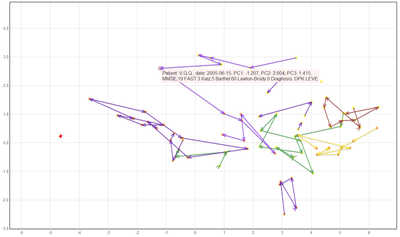A new cognitive component of visualization tool for diagnosis and monitoring Alzheimer's disease and other dementias: COGVIT
Václav Papež (The University of West Bohemia, Pilsen, Czech Republic), Petr Jaroš (The University of West Bohemia, Pilsen, Czech Republic), Carmen Paz Suárez Araujo (University of Las Palmas de Gran Canaria, Las Palmas de Gran Canaria, Spain), Miguel Ángel Pérez del Pino (University of Las Palmas de Gran Canaria, Las Palmas de Gran Canaria, Spain), Patricio García Báez (University of La Laguna, La Laguna, Spain)
This abstract introduces neuroinformatics research at University of Las Palmas de Gran Canaria (ULPGC). The research group Comciencia in cooperation with University of La Laguna (ULL) develops and improves software tools for physicians dealing with diagnostics of dementia. The main problem with diagnostics of cortical dementia is that a physician can surely decide about specific dementia even in its severe stages. The researches at mentioned institutions try to shorten the time necessary for successful diagnosis. New technologies and tools should allow us to predict dementia with some probability and allow physicians to treat dementia in its early stage.
COGVIT is a software tool which allows user to process and visualize medical records. These records are processed by the Sanger’s artificial neuronal network (uses the generalized Hebbian rule) and the result in the form of principal components is visualized. Input data are vectors. Each patient has his/her vector of results from psychological tests carried out during each consultation. Consequently these vectors create a matrix which is compressed to principal components by the Sanger’s network. First few components have their specific meaning (e.g. cognitive, physical etc.). It is possible to show patient’s disease deterioration or improvement over a time period (Cartesian coordinates) dependent on two selected principal components (axes). This graph is interactive and given information is easily readable for physicians. It helps them to observe patient’s state, to compare it with other patients and to predict Alzheimer disease or other cortical dementia with a higher probability.
Functionality of COGVIT itself highly depends on the amount of data. Then the work focuses (except integration of the Sanger’s network into COGVIT) also on data storage and integration of the COGVIT into the web portal Edevitalzh (developed also at ULPGC). The concept of the Edevitalzh portal is to create a centralized database for medical data accessible from various medical institutions. In that case COGVIT could work with a lot of data from many institutions. This allows us to train the Sanger’s network on huge amount of data and to bring better results in dementia prediction. Finally this integration makes Edevitalzh more powerful.
COGVIT is now prepared to store and analyze records of cortical dementias, but the basic concept of this tool could be applied to other types of diseases


 Latest news for Neuroinformatics 2011
Latest news for Neuroinformatics 2011 Follow INCF on Twitter
Follow INCF on Twitter
